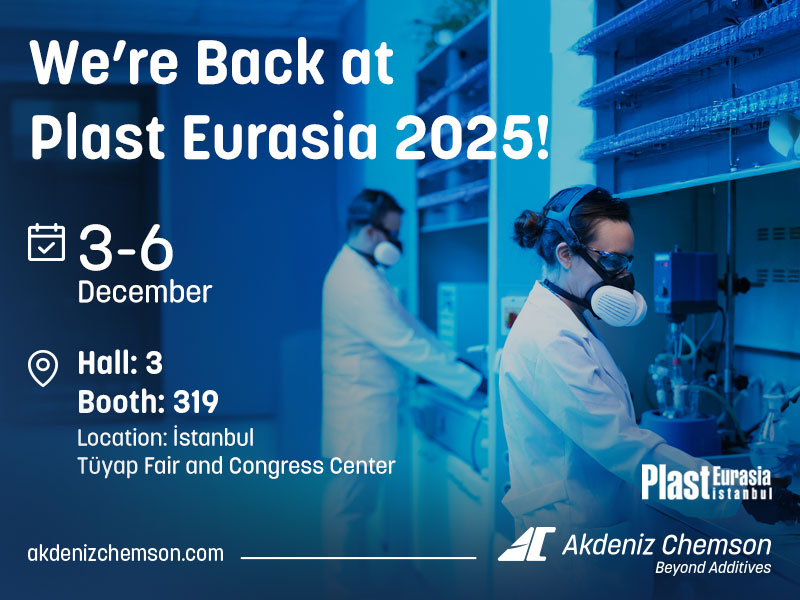Home > FAQ
FAQ
Thanks to years of experience in stabilizers, Akdeniz Chemson is able to offer more economical solutions to its business partners

Using rutile-type titanium dioxide, which has a higher refractive index and better UV absorption, will provide better coverage for the final product. In addition, the initial coloring of the product will be better when using anatase-type titanium dioxide in cable applications.
As the K-value, which expresses the chain length of PVC in the polymer structure, changes, the application areas also change.
For flexible products (cable applications, hoses, artificial leather, shoe soles, etc.) it is recommended to use PVC with K-values between 70 and 74.
It is recommended to use PVC in the K65-68 value range for products such as door-window profiles, inflexible sheets, exterior cladding and rain gutters.
In pipe applications; PVC should be used in the K58-67 value range for drainage pipe production, in the K65-67 value range for waste water pipes, and in K67 and above values for clean water pipes in order to obtain good results in the quality tests of the final product.
For 2mm edgebanding and cable tray-like products, it is recommended to use PVC in the K63-65 value range.
In profile applications, coated calcite with an average particle size of around 1 micron is mostly used. The high particle size of calcite will reduce the impact strength and cause premature wear on the mixer blades and the auger-sleeve of the extruder. If the particle size of calcite is too low, it may cause agglomeration in the dry powder mixture and marks on the surface of the final product. Calcite’s particle size is as important as its coating ratio. The coating ratio of calcite should be between 0.7% and 1.5%. Excessive coating ratios can cause plate-out problems in the calibrator.
In applications with high calcite utilization rate, it will be more advantageous to use extruders with conical screws instead of parallel screw extruders. Conical screws, due to their design, will reduce the plasticization time of the material during extrusion and provide easier processing of the mixture with high amounts of calcite.
In order to obtain a homogeneously mixed, dehumidified, easy flowing powder mixture in the mixer, the raw materials, which are gradually cooked up to 120°C in the hot boiler of the mixer for 5 to 8 minutes, should be cooled gradually to 40-50°C in the cold boiler of the mixer within 4 to 5 minutes. In order to obtain a homogeneous mixture in the mixer, the filling rate of the mixer should be 75% of the mixer capacity.
Mixer blades become worn and dysfunctional over time due to prolonged use and high calcite content. If the mixer time is getting longer, if there is an increase in amperage during the mixing process compared to the standard, and if the mixture sticks to the blades like slime or wear is evident when the blades are checked, we can understand that it is time to replace the blades.
PRO-30, PRO-40 and PRO-60, acrylic process auxiliaries produced by Akdeniz Chemson, shorten the plasticization time in general PVC applications, have a positive effect on surface gloss and provide a homogeneous melt flow. PRO-45 and PRO-70 with high molecular weight are advantageous in foam applications. PRO-45 improves the gas retention ability of the melt, resulting in more homogeneous foam with lower density. PRO-70 provides melt resistance to the material and prevents the foam bubbles formed during extrusion from escaping to the upper surface of the product when it is released from the pressure at the exit of the mold, thus providing an effective foam layer formation. PRO-50 is an acrylic process aid with lubricating properties. The use of PRO-50 reduces the tendency of PVC melts to adhere to hot metal surfaces, prevents mold contamination, and provides a glossier surface for the final product.
Moisture in the raw material and dry mix will disrupt the flow of the material prior to extrusion and cause lumping, as well as plate-out in the calibrator and bearding at the die exit. To prevent this, PVC and calcite should be checked for unwanted moisture. Mixing conditions (temperature, amperage) should be reviewed to ensure optimum operation. The use of jet filters at the mixing stage will be effective to reduce moisture.
The lubricants used in PVC production show different effects on process values according to their application types and structures. Generally speaking, the lubricants produced by Akdeniz Chemson are used as internal lubricants, external lubricants and oxidized polyethylene lubricants. While internal sliders generally do not make major changes in torque and pressure parameters, external sliders reduce torque and pressure. Oxidized PE lubricants have the opposite effect, increasing the torque and pressure parameters of the extruder. The usage rate of each lubricant varies according to the application recipe.
Calcite (Calcium Carbonate) has a positive effect in PVC applications by giving impact strength to the final product up to 9 phr, while the use of more than 9 phr reduces the breaking strength of the material. In addition, since calcite is a yellow material by nature, it changes the color values of the final product and this means more pigment and titanium dioxide for the manufacturer. Since calcite is a corrosive material, the use of high calcite seems to reduce the total cost of the final product in the short term, but in the long term, the use of high calcite has a great impact on the hidden costs of the manufacturer (replacement of auger-sleeve, replacement of mixer blades, customer complaints due to quality problems). On the other hand, since the density of calcite is greater than the density of PVC, it does not reduce the unit production price of the material much for PVC profile producers selling in meters, while it shows a greater cost reduction for companies selling in kilograms.
The application rate of impact strength enhancers varies according to the type of product made of PVC. In general, our customers can aim to solve strength problems by increasing the input of the impact strength enhancer product in the application formula in PVC profile applications where high calcite is used. Impact strength enhancers are used between 4 and 7 phr to get optimum impact strength effect in PVC profile production. The use of more than 7 phr does not have a positive effect on the material.
This is a complex issue involving formulation components, equipment, and stabilizers. Please contact Akdeniz Chemson.
The UV resistance of the pigments that provide coloring, i.e. high resistance to degradation against sunlight, is very useful in obtaining a long-lasting end product. It is recommended to use pigments with high light fastness called cool-color, where this feature is high. In addition, since laminated coated products have a lamination film on the surface, UV resistant lamination films are used.


